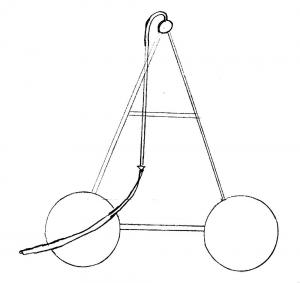Drag Socks Control Odors Caused By Land Application Of Animal Waste
 ✖  |
I was recently watching an Ag Day TV program about pivot-irrigated cotton in West Texas. The show interviewed Dr. John Burke with the USDA, and they showed a thing called a "drag sock". Its purpose was to get water down to the ground below the plant canopy in order to reduce evaporation and to help increase plant pollination. I work for the Missouri Department of Natural Resources as a CAFO inspector, and we get a lot of complaints about odors. When I saw the drag socks I knew they would have great potential for controlling odors caused by land application of animal waste. The idea is to dribble lagoon effluent out the end of the tube and onto the ground, where it's below the plant canopy and therefore results in reduced odors. You'll also reduce nitrogen volatilization and water evaporation.
You take a length of canvas and sew it into a tube which you attach over the drop-down nozzles on the center pivot. The weight of the canvas doesn't matter except that heavier weight canvas will probably last longer. The tube should be 2 to 4 ft. longer than the distance between the nozzle and the ground, so the tube can drag out behind the center pivot.
This idea will work on crops like alfalfa and soybeans. I don't know how it would work on a tall crop like corn. The main thing is to make sure you get a good distribution of effluent across the field so there's no runoff. It may require increasing the number of drop-down nozzles or teeing off drop-downs. The soils should be relatively dry to soak up the lagoon effluent. There's a bit of flooding under the sock, but it won't flood an area like a traveling gun will. (George Parsons, 1203 SW 90th Rd., Asbury, Mo. 64832 ph 417 842-3368; E-mail: katyscantina@tiadon.com)

Click here to download page story appeared in.
Click here to read entire issue
Drag Socks Control Odors Caused By Land Application Of Animal Waste MANURE HANDLING Equipment 25-6-35 I was recently watching an Ag Day TV program about pivot-irrigated cotton in West Texas. The show interviewed Dr. John Burke with the USDA, and they showed a thing called a "drag sock". Its purpose was to get water down to the ground below the plant canopy in order to reduce evaporation and to help increase plant pollination. I work for the Missouri Department of Natural Resources as a CAFO inspector, and we get a lot of complaints about odors. When I saw the drag socks I knew they would have great potential for controlling odors caused by land application of animal waste. The idea is to dribble lagoon effluent out the end of the tube and onto the ground, where it's below the plant canopy and therefore results in reduced odors. You'll also reduce nitrogen volatilization and water evaporation.
You take a length of canvas and sew it into a tube which you attach over the drop-down nozzles on the center pivot. The weight of the canvas doesn't matter except that heavier weight canvas will probably last longer. The tube should be 2 to 4 ft. longer than the distance between the nozzle and the ground, so the tube can drag out behind the center pivot.
This idea will work on crops like alfalfa and soybeans. I don't know how it would work on a tall crop like corn. The main thing is to make sure you get a good distribution of effluent across the field so there's no runoff. It may require increasing the number of drop-down nozzles or teeing off drop-downs. The soils should be relatively dry to soak up the lagoon effluent. There's a bit of flooding under the sock, but it won't flood an area like a traveling gun will. (George Parsons, 1203 SW 90th Rd., Asbury, Mo. 64832 ph 417 842-3368; E-mail: katyscantina@tiadon.com)
To read the rest of this story, download this issue below or click
here to register with your account number.







